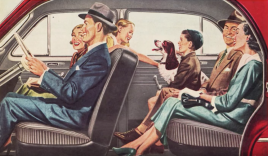In the 20th century, movement came to mean cars, especially as the end of the Second World War and the beginning of the 1950s came around, at which time President Eisenhower, "inspired by the awesome system of roads he saw in Germany," authorized the construction of a national highway system, the replacement for storied but non-comprehensive interstate roads like Route 66. From then on, the United States saw an enormous surge in both car ownership, auto-industry employment, "the middle class, suburbia, fast food," and a host of other phenomena still seen as characteristically American. "To say that modern America was built both by and for the car," as Rugnetta puts it, "would not be an insane overstatement." But he also notes that the idea of the road trip itself goes back to 1880s Germany, when Bertha Benz, wife of Benz Moterwagen founder Karl Benz, took her husband's then-experimental car on a then-illegal 66-mile drive through the countryside. The first American road trip was taken in 1903 by a doctor named Horatio Jackson and, as the Rough Guides video above tells it, involved a bet, a dog, and — the whole way from San Francisco to New York — no signage at all.










